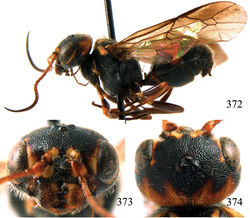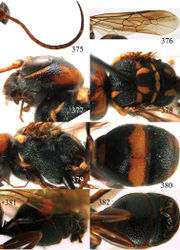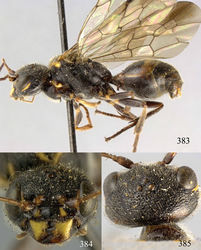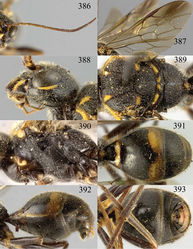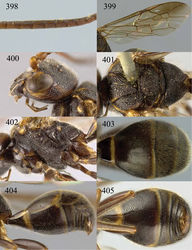Taeniogonalos formosana
| Notice: | This page is derived from the original publication listed below, whose author(s) should always be credited. Further contributors may edit and improve the content of this page and, consequently, need to be credited as well (see page history). Any assessment of factual correctness requires a careful review of the original article as well as of subsequent contributions.
If you are uncertain whether your planned contribution is correct or not, we suggest that you use the associated discussion page instead of editing the page directly. This page should be cited as follows (rationale):
Citation formats to copy and paste
BibTeX: @article{Chen2014ZooKeys385, RIS/ Endnote: TY - JOUR Wikipedia/ Citizendium: <ref name="Chen2014ZooKeys385">{{Citation See also the citation download page at the journal. |
Ordo: Hymenoptera
Familia: Trigonalyidae
Genus: Taeniogonalos
Name
Taeniogonalos formosana (Bischoff, 1913) – Wikispecies link – Pensoft Profile
- Poecilogonalos formosana Bischoff, 1913: 151; Tsuneki 1991[1]: 51; Weinstein and Austin 1991[2]: 423.
- Taeniogonalos formosana; Carmean and Kimsey 1998[3]: 67.
- Poecilogonalos intermedia Chen, 1949: 12; Marshakov 1981[4]: 106; Weinstein and Austin 1991[2]: 423; He and Lou 2001[5]: 686. Syn. n.
- Taeniogonalos intermedia; Carmean and Kimsey 1998[3]: 68.
- Poecilogonalos unifasciata Chen, 1949: 13; He 2004[6]: 75. Synonymized by Marshakov 1981[4] with Poecilogonalos maga (Teranishi, 1929). Syn. n.
- Poecilogonalos unifasciatas (!); He and Lou 2001[5]: 687.
Type material
Holotype of Poecilogonalos formosana, + (ZMB), “[China:] Formosa, Taihorin, X.[19]10, H. Sauter S.G.”, “formosana Bisch.*, det. Bischoff”, “Type”. Holotype of Poecilogonalos intermedia, + (IZCAS), “[China: Zhejiang,] T’ienmu Shan (= Mt. Tianmu), Musee Heude”, “25.VI.[19]36, O. Piel”, “Poecilogonalos intermedia n. sp.”. Holotype of Poecilogonalos unifasciata, > (IZCAS), “[China: Zhejiang,] Tienmushan, 24.VII.1937, Ouchi”, “Poecilogonalos unifasciata Chen”.
Additional material
4 + + 3 > (ZJUH, RMNH) “[China:] Henan, Luoshan County, Mt. Ling, 22.V.2000, Ping Cai, 200101850, 200101863, 200101872, 200101865, 200101856, 200101894, 200101851”; 2 > (ZJUH), “[China:] Jilin, Dongliao, 22–31.VII.1988, Xiao-Ming Lou, 888612, 888344”; 1 + (SCAU), “[China:] Jilin, Zuojia Nature Reserve, 15.VIII.2012, Liang Fan, SCAU 358”; 2 + (ZJUH), “[China:] Shanxi, Lishan Nature Reserve, 26–30.VII.2012, Zheng Liu, 201200420, 201200429”; 1 + + 1 > (SCAU) “[China:] Ningxia, Mt. Liupan, Qiuqianjia, 9–11.VII.2009, Guang-yue Wang, SCAU 022; id., but 8.VII.2008, 200801031”; 1 > (SCAU) id., but 6.VII.2008, Gang Yao, 200800478; 2 + + 1 > (ZJUH) “[China:] Henan, Song County, Mt. Baiyun, 1400 m, 26.VII.2003, Yan-bing Shen, 20047322; id., but 22.VII.2003, Tao Yang, 20047316; id., but 24.VII.2003, Jing-bo Li, 20047320”; 1 > (ZJUH) “[China:] Henan, Dengfeng, Mt. Shaoshi, 800 m, 9.VI.2000, Xiao-cheng Shen, 20047327”; 5 + + 1 > (ZJUH) “[China:] Zhejiang, Mt. Tianmu, 18.VI.1983, Yun Ma, 831376, 831380; id., but 27.VII.1988, Ying Qian, 940233; id., 21.VII.1987, Xue-xin Chen, 940234; id., but 3.VII.2010, Qing-ling Miu, SCAU 074, 079”; 5 + (ZJUH, RMNH), “[China:] Zhejiang, Mt. Tianmu, Xianrending, 1509 m, Qiong Wu, 20034562; id., but 20.VII.1998, MT, 992747; id., but 14.IX.1998, 200010706; id., but 5.IX.1998, light trap, 200010702”; 1 + + 3 > (ZJUH, RMNH) “[China:] Zhejiang, Longquan, Mt. Fengyang, 30.V.2007, Sheng-long Liu, 200704937; id., but 11.VII.1984, 8433553,; id., but 31.VII.2008, Jing-xian Liu, 200801104, 200801105”; 1 > (ZJUH) “[China:] Fujian, Chong’an, Mt. Huanggang, 30.VII.1985, Ming-hui Liu, SCAU 091”; 1 + (ZJUH) “[China:] Hunan, Mt. Tianping, 26.VIII.1981, Xin-wang Tong, 896471”; 2 > (RMNH) “[China:] Guangdong, Nanling Nature Reserve, VI.2011, Zai-fu Xu et al.”; 2 + (ZJUH) “[China:] Sichuan, Mt. Emei, 7.VII.2009, Jiang-li Tan, 200906432, 200906432”; 1 + (ZJUH) “[China:] Guizhou, Daozhen, Dashahe Nature Reserve, 1360 m, 21.VIII.2004, Qiong Wu, 20047404”; 1 + (ZJUH) “[China:] Guizhou, Kuankuoshui National Nature Reserve, 1450 m, 6.VIII.2003, Qiong-zhang Song, SCAU 359”; 1 > (ZJUH) “[China:] Tibet, Yarlung Zangbo Grand Canyon, 10.VI.2009, Jiang-li Tan, 200906509”; 1 + (ZJUH) “[China:] Yunnan, Tengchong, Houqiao Town, 1.VI.2009, Jiang-li Tan, 200907082”; 1 + (ZJUH) “[China:] Yunnan, Dali, Yunlong, 3.VI.2009, Jiang-li Tan, 200906611”; 1 + (ZJUH) “[China:] Yunnan, Kunming, 18.V.1981, Jun-hua He, 814751”.
Diagnosis
Supra-antennal elevations 0.1–0.4 times as long as scapus and outer side of elevations moderately oblique (angle about 35°; Figs 374, 385, 396); area between elevations comparatively shallowly depressed (Figs 374, 385, 396); head anteriorly and posteriorly, mesosoma dorsally and pronotum laterally more or less with a yellowish or brownish pattern (Figs 373, 374, 378, 379), including a more or less developed V-shaped yellow or orange pattern behind stemmaticum, area besides stemmaticum variable, often dark brown (Fig. 374); V-shaped pale area of head dorsally with smooth interspaces between punctures (Fig. 374); clypeus shallowly emarginate medio-ventrally (Fig. 373); middle mesoscutal lobe similar to lateral lobes, black or yellow laterally and black medially (Figs 378, 389, 401); notauli smooth posteriorly (Fig. 378); mesopleuron black or at most with medio-dorsal orange-brown patch and metapleuron black (Fig. 379); third submarginal cell of fore wing 0.7–1.0 times as long as second submarginal cell (Fig. 376); basal cell and posterior half of first submarginal cells of fore wing subhyaline (but costal cell more or less dark brown), distinctly paler than marginal cell (Fig. 376); propodeal foramen comparatively wide and less arched (Fig. 389, 401); second tergite bicoloured (Fig. 380), anteriorly black and posteriorly yellow; third–fifth metasomal tergites with yellow patches postero-laterally; second sternite of both sexes without medio-apical protuberance (Fig. 382), distinctly convex and no opening between second and following sternites in lateral view (Fig. 382); third sternite of female without apical ledge (Fig. 382); sixth tergite with black central patch, surrounded by U-shaped yellow patch (Fig. 382).
Description
Holotype, female, length of body 7.9 mm (of fore wing 7.1 mm).
Head. Antenna with 24 segments; frons densely punctate and narrow smooth interspaces; vertex punctate with medium-sized smooth interspaces but pale posterior area with wide interspaces and distinctly shiny (Fig. 374), with medium-sized setae; temple largely smooth with sparse fine punctures (Fig. 377), but less sparsely near eye; head subparallel behind eyes, eye in dorsal view as long as temple (Fig. 374); occipital carina narrow, non-lamelliform, smooth (Fig. 374); supra-antennal elevations medium-sized (about 0.5 times as long as scapus), outer side oblique (angle about 35°) lamelliform and largely smooth (Fig. 374); area between elevations shallowly concave; clypeus slightly concave and thick medio-ventrally.
Mesosoma. Length of mesosoma 1.2 times its height (Fig. 379); mesopleuron densely and coarsely punctate-rugose, with satin sheen; transverse mesopleural groove medium-sized, shallow and distinctly crenulate; notauli narrow, deep and smooth; middle lobe of mesoscutum transversely rugose, lateral lobes vermiculate-rugose and partly rather shiny (Fig. 378); scutellar sulcus complete, narrow and finely crenulate; scutellum densely rugose but largely smooth posteriorly, convex laterally, near level of mesoscutum, flattened medially and posteriorly; metanotum medially flattened and finely rugose (Fig. 378); propodeum largely obliquely rugose (Fig. 378); posterior propodeal carina thick lamelliform and medium-sized, foramen moderately arched and 1.2 times higher than wide basally.
Wings. Fore wing: vein 1-M as long as vein 1-SR (Fig. 376), distinctly curved and vein 1-SR widened anteriorly; second submarginal cell about as long as third cell.
Metasoma. First tergite 0.4 times as long as apically wide, largely smooth and with shallow linear depression medially (Fig. 380); other tergites largely densely punctate (Fig. 380); all sternites densely punctate, but third sternite finely coriaceous anteriorly; second sternite moderately convex and medio-posteriorly truncate and densely setose in lateral view (Fig. 381); third sternite distinctly depressed posteriorly.
Colour. Black; orbita yellow, narrow but widened near antennal sockets, supra-antennal elevations largely yellow and connected to yellow patch (Fig. 374), clypeus with pair of large yellow patches; head posteriorly brownish-yellow, including two pairs of oblique patches; mandibles largely dark brown with some yellow near base of teeth; mesosoma laterally black except for dorsal and ventral yellow patches of pronotal side; middle lobe of mesoscutum with pair of triangular yellow patches anteriorly; tegulae yellow; scutellum laterally and axilla with pair of large yellow patches; metanotum with a large medial and a large lateral patch yellow; propodeum pair of large yellow patches (Fig. 378); first tergite ivory medio-posteriorly, second tergite widely yellow posteriorly, third tergite with pair of small yellow patches postero-laterally; fourth–sixth tergites with pair of large yellow patches; metasoma ventrally black but apical margin of first sternites yellowish and apex of hypopygium brownish (Fig. 382); palpi and apical half of antenna brown; remainder of antenna mainly light brown; apex of trochanters, trochantelli largely, anterior stripe on fore tibia, base of all femora and apex of fore and middle femora, base of middle and hind tibiae pale yellow; remainder of tibiae and tarsi more or less dark brown; pterostigma and marginal cell of fore wing largely and area below it dark brown; remainder of wing membrane slightly infuscate.
Male. Similar to the pale and dark (= “unifasciata”) forms of the female, but vertex and frons largely black; second sternite distinctly flattened medially; tyloids linear.
Variation. The pale and typical form has the supra-antennal sockets largely yellow (Fig. 374), but these are largely or entirely black or dark brown in the dark form (Fig. 385). The vertex is partly yellowish brown or orange posteriorly (Fig. 374), sometimes including posterior part of frons, but rather obscurely so in the dark form (Fig. 385); lobes of mesoscutum sometimes largely orange laterally; yellow medial patch of metanotum is sometimes divided into two patches; metasoma finely to coarsely punctate dorsally; second–fifth sternites laterally black or partly orange; second submarginal cell of fore wing 1.0–1.5 times as long as third cell.
Biology
Collected in May–August and October at 800–1509 m.
Distribution
China (Jilin, Shanxi, Ningxia, Henan, Fujian, Taiwan, Zhejiang, Guangdong, Sichuan, Yunnan, Guizhou, Tibet); Russia; Japan.
Notes
Poecilogonalos intermedia Chen, 1949 (+), and Poecilogonalos unifasciata Chen, 1949 (>), are synonymized here with Taeniogonalos formosana, because they share the less steeply protruding supra-antennal protruberances (angle about 35°; Figs 374, 385, 396), the more or less brownish or yellowish vertex posteriorly, head anteriorly and mesosoma dorsally with a yellowish pattern and differ only in colour from Taeniogonalos formosana (Bischoff) and intermediates are present. If the melanistic form should be named, then f. intermedia (Chen) is available; Trigonalys lachrymosa (Westwood, 1874), comb. n. from Philippines has a similar colour pattern but a different venation according to the original description. Taeniogonalos taihorina (Bischoff, 1914) is very similar to the dark form of Taeniogonalos formosana, but differs by having the area between the supra-antennal protuberances distinctly concave and the protuberances more steeply protruding laterally (angle about 45°), the pronotum laterally, the head anteriorly and the mesosoma dorsally entirely black.
Taxon Treatment
- Chen, H; van Achterberg, C; He, J; Xu, Z; 2014: A revision of the Chinese Trigonalyidae (Hymenoptera, Trigonalyoidea) ZooKeys, 385: 1-207. doi
Other References
- ↑ Tsuneki K (1991) Revision of the Trigonalidae of Japan and adjacent territories (Hymenoptera). Special Publications Japan Hymenopterists Association 37: 1-68.
- ↑ 2.0 2.1 Weinstein P, Austin A (1991) The host relationships of trigonalyid wasps (Hymenoptera: Trigonalyidae), with a review of their biology and catalogue to world species. Journal of Natural History 25(2): 399–433. doi: 10.1080/00222939100770281
- ↑ 3.0 3.1 Carmean D, Kimsey L (1998) Phylogenetic revision of the parasitoid wasp family Trigonalidae (Hymenoptera). Systematic Entomology 23: 35–76. doi: 10.1046/j.1365-3113.1998.00042.x
- ↑ 4.0 4.1 Marshakov V (1981) [Trigonalidae (Hymenoptera) of the USSR fauna]. In: Korotyaev B (Ed) Morfologia i sistematica nasekomykh Dalnego Vostoka [Morphology and Systematics of insects of the Far East]. Nauka, Leningrad 92: 100–107. [in Russian]
- ↑ 5.0 5.1 He J, Lou X (2001) Hymenoptera: Trigonalyidae. In: Wu H Pan C (Eds) Insects of Tianmushan National Nature Reserve. Science Press, Beijing, 686-687. [in Chinese]
- ↑ He J (2004) Hymenopteran Insect Fauna of Zhejiang. Science Press, Beijing, China. [in Chinese]
Images
|
